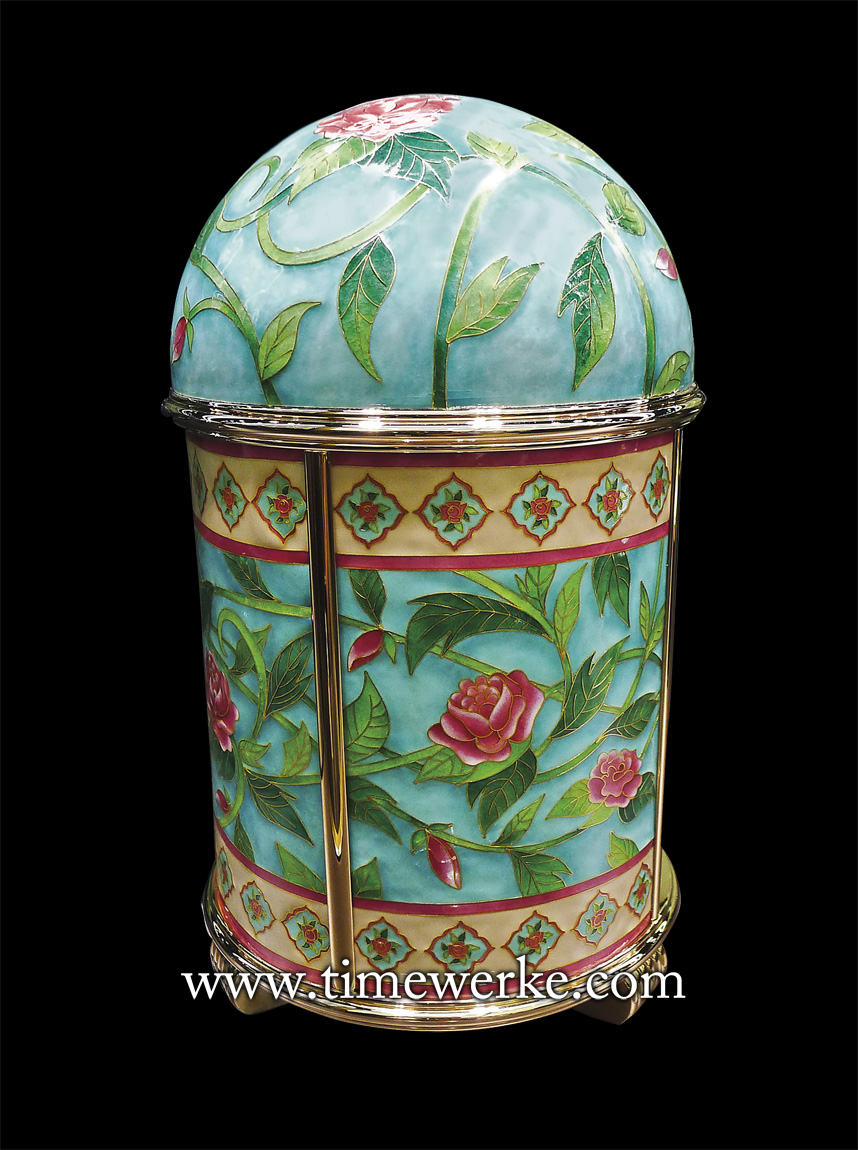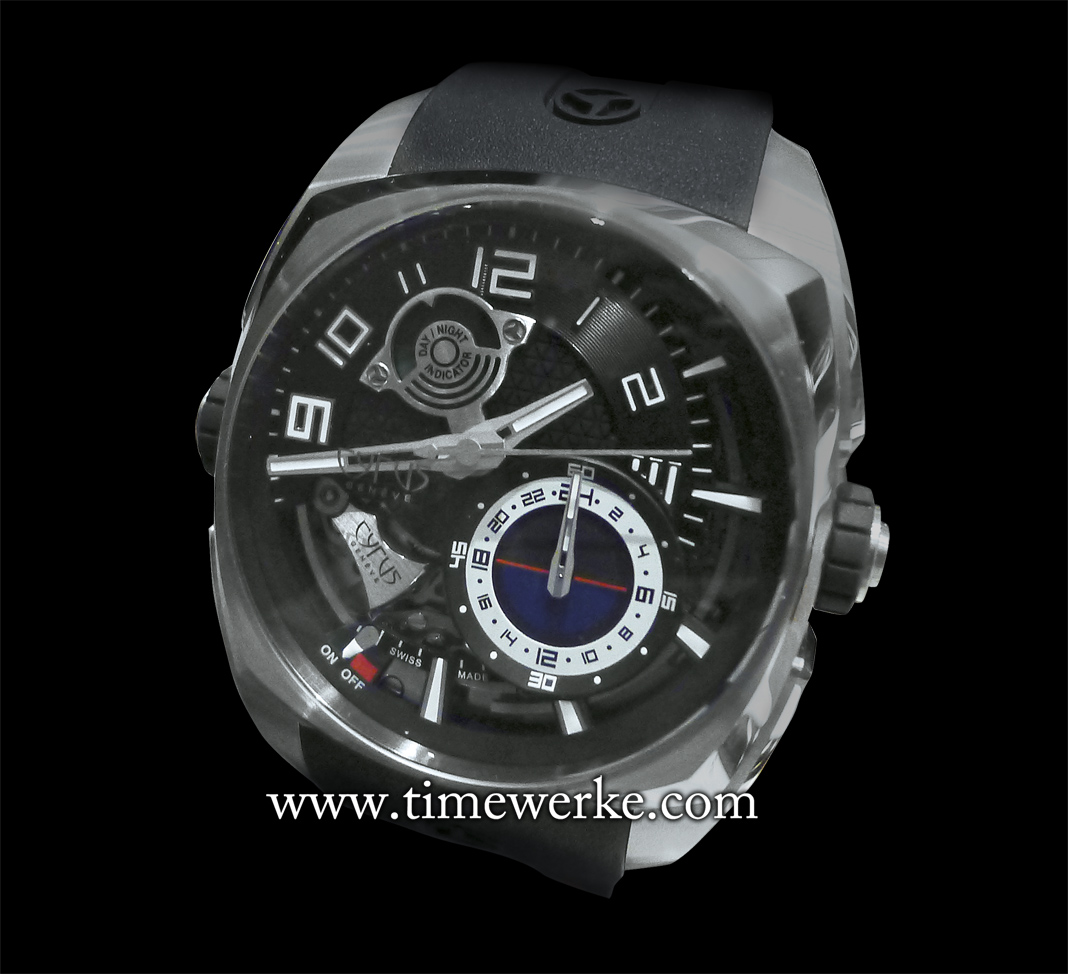
A closer detailed view of the enamel painting on the Patek Philippe Ref. 1665M “Peranakan Culture” dome table clock in cloisonné enamel. The rose and geometric figures were created by the enameller who first outlined the design using more than 28 metres of gold wire weighing 53.5 grams with the cross-section measuring 0.2mm by 0.6mm. The outlined cells are then filled with transparent, opaque and opalescent enamel in 14 colours. Each element required between seven and eight firings at temperatures of about 890 degrees Celsius. Take note of the vibrant colours thanks to the enamel artwork. Such colours are typical of Peranakan style decorations on tableware. Photo: © TANG Portfolio. Elfa / Timmy. 2015 BaselWorld
To appreciate the Patek Philippe Ref. 1665M “Peranakan Culture” dome table clock in cloisonné enamel, perhaps the first and most important question for the uninitiated is: what is a Peranakan?
The term “Peranakan” is both a Malay and Indonesian word and it means “descendant” or “local-born” when translated to English. It is generally used to describe descendants of early Chinese immigrants or Straits-Chinese in Southeast Asia, mainly those of mixed Chinese-Malay or Chinese-Indonesian heritage.
The consensus is that the origins of Peranakans date back to the 15th century after Chinese immigrants, mostly traders, married natives of the Malay Archipelago. It is even said that Chinese immigrants married Balinese or Batak slaves. The offspring of these early Chinese settlers were born locally, which would explain the term “Peranakan”.
According to The Peranakan Association Singapore, the oldest Chinese communities can be found in Malacca. When Chinese Admiral Cheng Ho (1371 to 1433) made his port of call in Malacca in the early 1400s, it is said that there was already a Chinese community there.
Admiral Cheng Ho’s visit marked stronger relations between China and Malacca, which during the early 15th century, was ruled by Parameswara (1344 to 1414), the first Sultan of Malacca. It is said that his son, Iskandar Shah, was the second ruler of Malacca.
Parameswara was the last king or Raja of Singapura – which is today known as Singapore. Parameswara ruled Singapura in 1390 or 1391. He fled the island in 1395 or 1396 after it was attacked by the Majapahits from Java.
Parameswara established his new base in the Bertam river in the west coast of the Malay Peninsular around 1400 and it eventually became the capital of the Malacca Sultanate.
After Admiral Cheng Ho’s visit to the region, trade with China flourished further with more Chinese merchants arriving in Southeast Asia. Many Chinese immigrants settled in Malaysia (notably Malacca and Penang), Indonesia and Singapore.
Perhaps the influx of large numbers of male Chinese immigrants in the region resulted in more marriages with the native females and the beginning of the Peranakans.
Male Chinese Peranakans are known as babas while female Chinese Peranakans are called nyonyas (or nonyas).
Peranakans are also known today as the Straits Chinese. This is because they were usually born in the British-controlled Straits Settlements of Singapore, Penang and Malacca, as explained in the highly informative article, Peranakan (Straits Chinese) community by Jaime Koh.
The article further adds that: “During colonial times, they were also known as the King’s Chinese in reference to their status as British subjects after the Straits Settlements became a Crown colony in 1867”.
Another point noted by Koh is that the Chinese Peranakans “were also generally from a higher socio-economic class than most Chinese immigrants…” and “many of the early Peranakans were entrepreneurial traders and shopkeepers. A significant number were also involved in real estate, shipping and banking sectors.
“As most of the Peranakans received an English education and were fluent in the language, many of them were appointed by the British authorities as community and civic leaders”.
Prominent Chinese Peranakans include Singapore’s first Prime Minister Lee Kuan Yew (1923 to 2015), Singapore’s fourth President Wee Kim Wee (1915 to 2005) and philanthropist Lim Boon Keng (1869 to 1957), Singapore’s first Queen’s scholar who was a doctor.
Another Peranakan name many in Singapore will be familiar with is Tan Tock Seng (1798 to 1850), a wealthy merchant and philanthropist who was born in Malacca. The Tan Tock Seng Hospital located at Outram Road in Singapore is named after him.
Not all Peranakans are of Chinese ancestry, highlights Jaime Koh in her article, as there were also the Peranakan Indians known as Chitty Melaka and Jawi Peranakans who were Straits-born Muslims of mixed Indian and Malay parentage.

Patek Philippe Ref. 1665M “Peranakan Culture” dome table clock in cloisonné enamel. Introduced in 2015, this pièce unique pays tribute to the Peranakans – the Straits-born Chinese who descended from the first immigrants to settle in the former British crown colony of Malacca, Penang and Singapore. The hour circle which is adorned with black enamelled Breguet numerals frames a dial centre hand-guilloched under a translucent rose pink enamel. Photo: © TANG Portfolio. Elfa / Timmy. 2015 BaselWorld
Patek Philippe’s one-of-a-kind “Peranakan Culture” dome clock which was on display at the 2015 BaselWorld watch fair, is a true beauty and an artwork to marvel at.
I was immediately reminded of my childhood, notably the vibrant Peranakan porcelain tableware my mother used for weekend dinner parties. What came to mind was what is termed the kat mau or covered jar with colours in lime green, pink and yellow.
According to the blog, enticz, it is known as kat mau in Singapore, chepu or chupu in Malacca and himcheng in Penang. Regardless, such colours are typical of the Peranakan tableware style and are simply beautiful.
The vibrant colours on the kat mau, as I was to later understand, are the result of enamelling. Such colours are typical of enamelled Chinese Porcelain from the 17th and 18th centuries and are known in French as famille verte (for green), famille jaune (for yellow) and famille rose (for red).
It is said that antique Peranakan tableware in enamelled porcelain were mostly made in Jingdezhen, Jiangxi Province in China. Back in those days, enamelled porcelain wares were considered luxury goods.
The flowers painted in vibrant colours à la Peranakan on Patek Philippe’s Ref. 1665M “Peranakan Culture” dome clock in cloisonné enamel are described as roses. Interestingly, the Peranakan tableware kat mau as I recall, was decorated with pink peonies, as it is more Oriental.

This one-of-a-kind Patek Philippe Ref. 1665M “Peranakan Culture” dome table clock evokes lots of emotions and the vibrant colours in enamel, like Peranakan tableware, remind us of typical enamelled Chinese Porcelain from the 17th and 18th centuries with colours known in French as famille verte (for green), famille jaune (for yellow) and famille rose (for red). Photo: © TANG Portfolio. Elfa / Timmy. 2015 BaselWorld
Looking once again at the roses on Patek Philippe’s Ref. 1665M “Peranakan Culture” dome clock, it may be difficult to differentiate between an artistic rose and that of a peony. Nonetheless, the dome table clock remains stunning and I am sure Peranakans and those familiar with Peranakan porcelain tableware will be highly appreciative of the fantastic artwork and inspiration behind it, especially if it evokes emotions, similar to what it has on me.
This pièce unique Patek Philippe Ref. 1665M “Peranakan Culture” dome clock in cloisonné enamel is what we would term a rare heritage piece not just for Peranakans but Patek Philippe as well simply because it deepens the richness of the artistry and craftsmanship the brand brings to the table (yes, pun intended) for cultured collectors.

